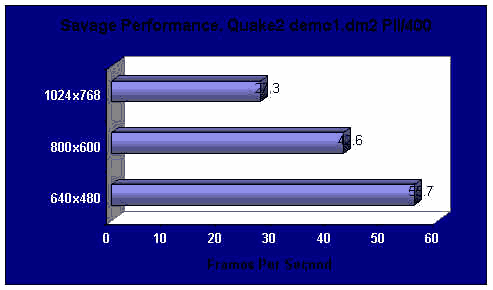I didn't bother posting to many performance scores since the performance of the AOpen PA70 is very similar to that of the Savage3D board Anand looked at in the large Video Accelerator Round-up. If you are interested in in-depth benchmarks on various games/etc. check this article out.
The Performance of the Savage3D is good. It isn't a Voodoo2 killer (In D3D games it actually does significantly outperform the Voodoo2) but performance is up there. Keep in mind that this board was running at 110mhz, not 125mhz like some of the review Savage boards that are floating around the web.There is however a problem with the Savage3Ds performance.
Vsync On/Off
The tests were conducted with Vsync Off to ensure that the frame rate was not being limited by Vsync (i.e. awaiting for Monitor refresh before drawing screen). Unlike some cards, which suffer minimally when turning Vsync On/Off, the Savage 3D's performance dropped insanely when I turned Vsync On. 800x600 Performance dropped from 42.6fps to 35.2! 1024x768 dropped from 27.3 - 23.7, 640x480 frame rates dropped to 43.9! (from 55.7). What does this mean? Well, in order to understand the significance of this large drop, you must first understand how frame rate is calculated. Frame rate is calculated as # total frames / amount of time. The frame counter is incremented every time a frame is drawn. We can also look at the FPS as Amount of Frames / certain amount of time, let us shrink this interval of time down to 1 second, and we get Frames / a Certain Second. Now we add up All the values from Frames / a Certain Second and divide by total number of frames. The problem is that, no matter how fast the Savage can actually render certain scenes, it will be capped by a 60hz (refresh I used for OpenGL tests) refresh rate. If a card did a consistent 40 frames / a certain second, whether or not Vsync was On/Off would be negligible. However, a card which very inconsistent performance, lets say anywhere from 15 to 150 frames / a certain second, will suffer greatly from Vsync On since every time the card hits above 60 frames / a certain second, the number will be capped to 60. Lets say we had a 3 second demo which Ran at (Vsync/off) 9fps / second1, 150 fps / second2 , 15 fps / second3. (Slight exaggeration of performance of any real card) This would yield an average FPS over the entire demo of 58fps (Vsync/off) Turn Vsync On in this test, and the 150fps / second2 will be changed to 60fps / second2. This will change the average FPS to 28fps, a HUGE difference. While the consistency of the Savage3D is much greater than the consistency in the example above, The Savage3D is still very inconsistent compared to other cards. (Most cards lose 2-3fps at most, provided Vsync/off performance is lower than refresh rate, which is the case with the Savage) This low consistency means that the Savage3D FPS can dip to extremely low rates, an issue Tom, of Tom's Hardware discusses more.
Another problem with Vsync is that it is not very pretty playing with it off, so the results you should really be concerned with are the Vsync On results. The tearing with the Savage3D is incredible; at 1024x768 it was horrendous. The screen was flashing and sometimes half the polygons weren't visible. I don't recommend shutting off Vsync during play, even though it increases speed. (Theoretically only, gameplay will not be any better due to Savage3D inconsistency).
Processor/Resolution Scaling
Looking at Anandtech's Video Accelerator Comparision; you will find that the Savage3D scales quite nicely with CPU speed. Not only that, on slower Pentium IIs, the Savage3D performs quite well compared to the competition in higher resolutions. This is definitely a good feature for PII/233, PII/266 owners; as you can bump up the resolution in most games (i.e. D3D) and still enjoy just about the same frame rate. In OpenGL games, such as Quake2, SiN, and Unreal, performance drops significantly as resolution increases; also, performance on lower end CPUs is only medicore.











0 Comments
View All Comments